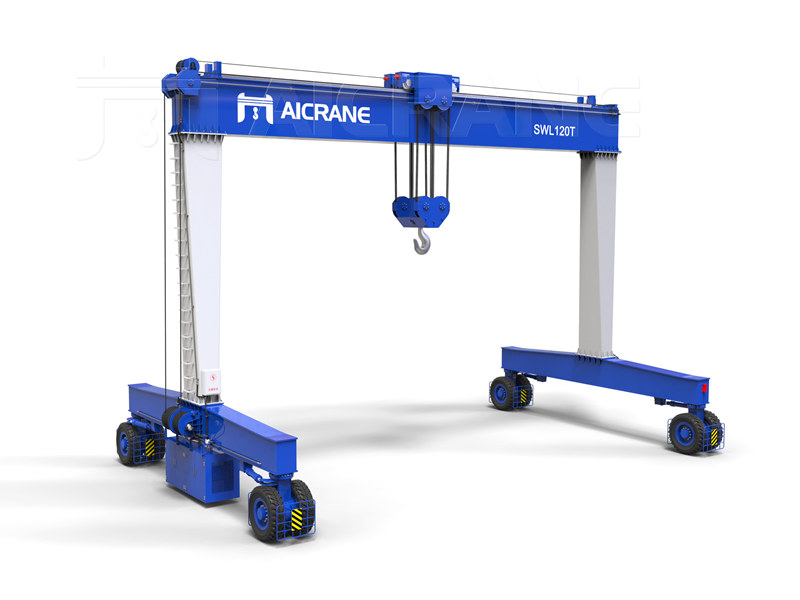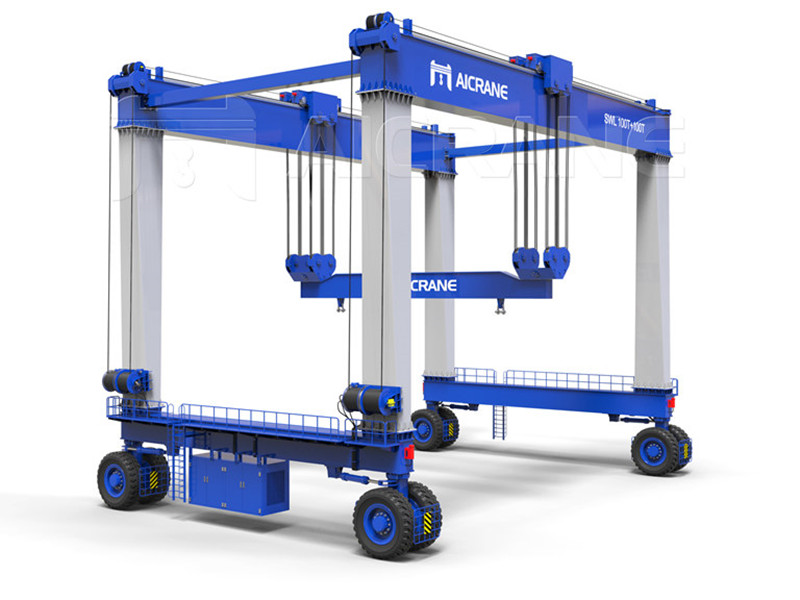The safe transportation of a rubber tyre gantry crane is a critical aspect of its overall lifecycle management. Whether it’s moving the crane within a facility, between job sites, or across long distances, careful planning and execution are essential to ensure the crane’s structural integrity, prevent damage, and guarantee the safety of personnel involved in the transportation process. In this guide, we will explore five key tips for the safe transportation of rubber tyre gantry cranes.

Thorough Inspection and Preparation
Before initiating the transportation process, a comprehensive inspection of the rubber tyre gantry crane must be conducted. This inspection should include a detailed assessment of the crane’s structural components, mechanical systems, electrical systems, and safety features. Any signs of wear, damage, or potential issues should be identified and addressed before transportation.
Key components to inspect include:
Structural Integrity: Examine the crane’s framework, beams, and structural elements for any signs of stress, cracks, or misalignment.
Mechanical Systems: Check the condition of mechanical components such as gears, brakes, and wheels. Ensure that all moving parts are well-lubricated and functioning correctly.
Electrical Systems: Inspect the control panels, wiring, and electrical connections for any damage or wear. Verify that all safety features and emergency shutdown systems are operational.
Safety Features: Confirm that safety features, such as limit switches, overload protection, and emergency braking systems, are in proper working order.
Once the inspection is complete, any necessary repairs or maintenance should be carried out. Additionally, the crane should be appropriately prepared for transportation, including securing loose components, covering sensitive areas, and, if applicable, removing and securing the crane’s boom.
Secure and Professional Rigging
The proper rigging of the rubber tyre gantry crane is fundamental to its safe transportation. This involves securely attaching the crane to the transport vehicle using high-quality rigging equipment. The rigging process should be carried out by trained and experienced professionals who understand the specific requirements of the gantry crane being transported.
Key considerations for secure rigging include:
Proper Attachment Points: Identify and use the manufacturer-recommended attachment points on the gantry crane. Avoid attaching rigging equipment to non-designed load-bearing components of the crane manufacturer.
Weight Distribution: Ensure that the weight distribution is even and balanced. This prevents uneven loading on the transport vehicle and minimizes the risk of tilting or tipping during transportation.
Use of Quality Rigging Equipment: Employ high-quality slings, straps, and chains with adequate load-bearing capacity. Regularly inspect rigging equipment for wear and tear, and replace any damaged components.
Secure Fastening: Double-check that all rigging connections are securely fastened, and use appropriate locking mechanisms to prevent unintentional detachment during transportation.
Professional Rigging Crew: Entrust the rigging process to a professional crew experienced in the transportation of gantry cranes. This ensures that industry best practices are followed and that safety standards are upheld.

Adherence to Weight Limits and Regulations
Compliance with weight limits and transportation regulations is crucial for the safe and legal transportation of rubber tyre gantry cranes. Exceeding weight limits can lead to structural damage to the crane, compromise the stability of the transport vehicle, and result in legal consequences.
Key aspects of adherence to weight limits and regulations include:
Weighing the Crane: Accurately determine the weight of the gantry crane, including all components and attachments. Use certified scales and consider the weight distribution on axles.
Permits and Authorizations: Obtain all necessary permits and authorizations for the transportation of oversized or overweight loads. Familiarize yourself with local, state, and national regulations governing the transportation of heavy equipment.
Escort Vehicles: Depending on the size and weight of the crane, escort vehicles may be required to accompany the transport. These vehicles help ensure the safe passage of the crane and alert other road users to the oversized load.
Route Planning: Plan transportation routes that are compliant with weight restrictions and regulations. Avoid roads, bridges, or tunnels that may have limitations on heavy loads.
Communication with Authorities: Communicate with relevant authorities, such as transportation departments and law enforcement agencies, to coordinate the movement of the gantry crane and address any concerns or restrictions.
Weather Monitoring and Contingency Planning
Weather conditions can significantly impact the safety of gantry crane transportation. Adverse weather, such as high winds, storms, or icy conditions, can pose serious risks to both the crane and other road users. Monitoring weather forecasts and having contingency plans in place are crucial components of safe transportation.
Key considerations for weather monitoring and contingency planning include:
Real-Time Weather Updates: Utilize real-time weather monitoring tools to stay informed about current and forecasted weather conditions along the transportation route.
Wind Restrictions: Be particularly cautious of high winds, as they can affect the stability of the gantry crane. Establish wind speed restrictions for safe transportation.
Contingency Routes: Identify alternative routes or safe locations to park and secure the crane in the event of sudden adverse weather conditions.
Communication Protocols: Establish clear communication protocols for the transportation crew, including procedures for monitoring weather updates and making real-time decisions based on changing conditions.
Safety Stop Protocol: Implement a safety stop protocol that empowers the transportation crew to halt the journey if weather conditions become unsafe. This may involve pre-determined wind speed limits or other weather-related criteria.
Professional Transportation Services
Engaging professional transportation services specializing in the relocation of heavy equipment, such as rubber tyre gantry cranes, is a prudent step to ensure safe and efficient transportation. These specialized services bring expertise, experience, and the necessary equipment to handle the unique challenges associated with transporting gantry cranes.
Key advantages of professional transportation services include:
Specialized Equipment: Professional transporters have specialized trailers, vehicles, and equipment designed for the secure and efficient transportation of heavy and oversized loads.
Experienced Crew: The crew of professional transportation services is experienced in the nuances of handling gantry cranes. They are trained in rigging, loading, securing, and transporting heavy equipment.
Insurance Coverage: Reputable transportation services typically provide insurance coverage for the transported equipment, offering financial protection in case of unforeseen incidents.
Compliance with Regulations: Professional transporters are well-versed in local and international regulations governing the transportation of heavy machinery. They ensure compliance with all legal requirements.
Efficient Route Planning: Transportation experts can optimize routes, taking into account factors such as road conditions, weight restrictions, and the most direct path to the destination.
In conclusion, the safe transportation of rubber tyre gantry cranes requires meticulous planning, adherence to safety protocols, and the involvement of experienced professionals. By following these five tips, stakeholders can contribute to the overall safety, efficiency, and successful relocation of these critical pieces of heavy machinery.
